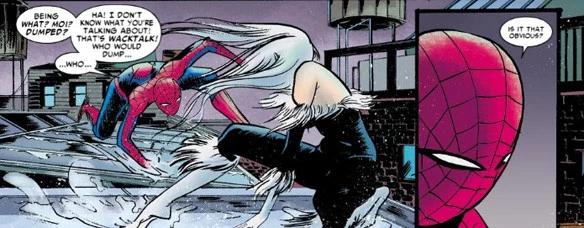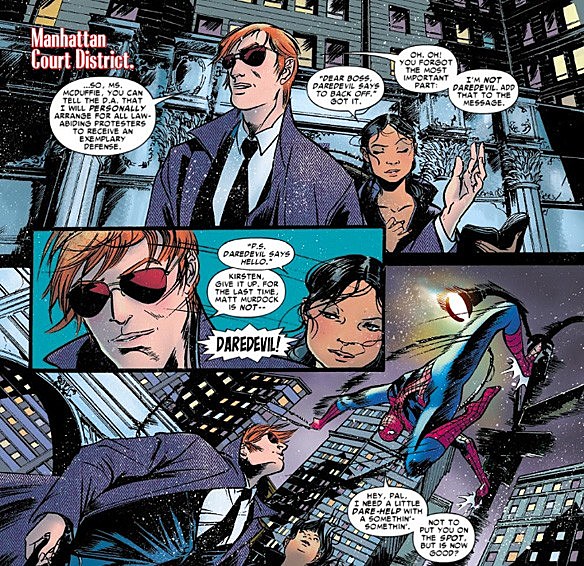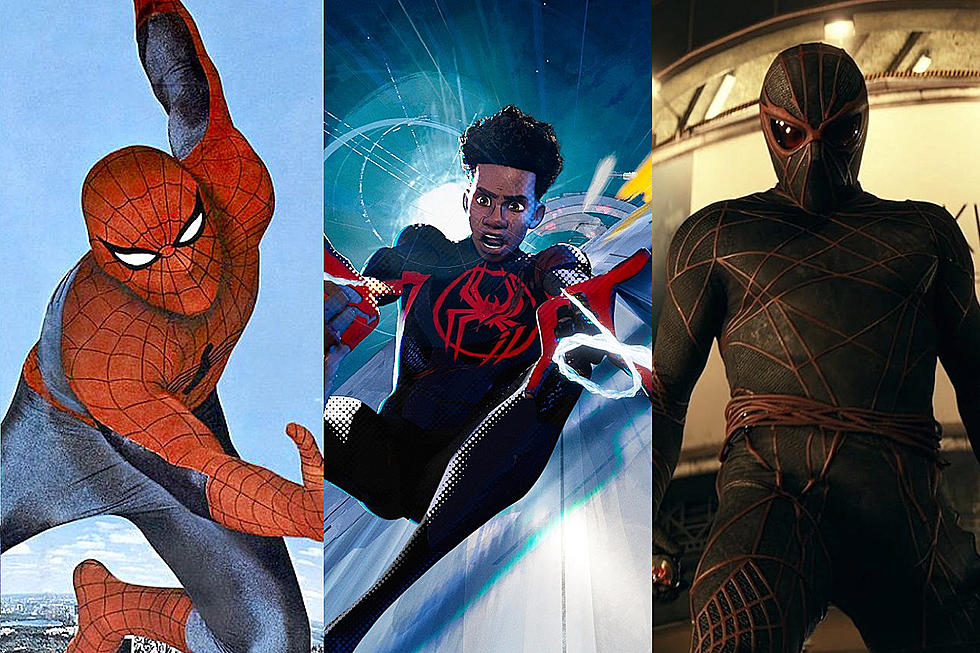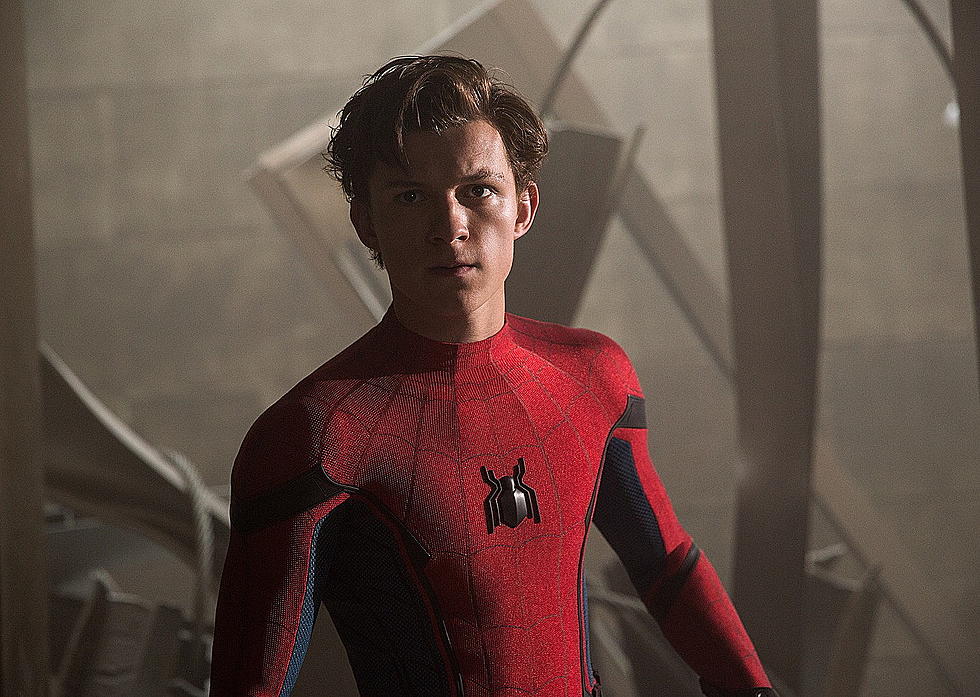
Spider-Man and Daredevil’s ‘Devil and the Details’ Is the First Great Comic of 2012

It was only a few weeks ago that I was writing about how Daredevil was my pick for the best super-hero comic of 2011, so the fact that it's kicking of 2012 as my undisputed favorite title on the stands shouldn't really be a surprise. But that's the thing about this book: Just when you're getting used to how good it is, just when you think you're wise to all the tricks that the creators are going to pull, it somehow gets better.
And that's exactly what's happened this week with "The Devil and the Details," a two-part crossover between Daredevil and Amazing Spider-Man by Mark Waid, Emma Rios, Kano and Javier Rodriguez, a story so well-crafted on every level that it's pretty much earned its slot on the next Best of the Year lists with 49 weeks to spare. I'll be honest, folks: I am an absolute sucker for a Spider-Man/Daredevil team-up story. They're two of my favorite characters individually, but it goes beyond that, and even beyond the fact that their similar powers and acrobatic movements make them the perfect visual compliments to each other in the hands of the right artist. It has to do with the way that they're structured.
I'll be honest, folks: I am an absolute sucker for a Spider-Man/Daredevil team-up story. They're two of my favorite characters individually, but it goes beyond that, and even beyond the fact that their similar powers and acrobatic movements make them the perfect visual compliments to each other in the hands of the right artist. It has to do with the way that they're structured.
They're a great mirror of each other in a lot of ways. One of the most appealing aspects of Spider-Man is that he's a guy who often suits up and goes out crime-fighting as a way to deal with the stress that he has in his otherwise crappy life, which is certainly where he starts out this story, and provides his entire reason for getting involved.
For Daredevil, it's the same way. His defining trait over the past thirty years or so has been that no matter what kind of monumentally tragic burdens he's had to carry on his shoulders, he's always faced it head on, leaping at it without a trace of fear. It's kind of his thing. It's only been recently, since Waid, Paolo Rivera and Marcos Martin relaunched the book last year, that this is something that's been portrayed as more lighthearted than, you know, suicidally depressing, but it's always been there, that willingness to deal with danger by throwing himself at it regardless of the consequences he might suffer so that he can triumph.
And the brilliant thing about this story -- well, one of about 45 different brilliant things, anyway -- is how Waid sets it up to all revolve around the particular problems that Spider-Man and Daredevil are having right now and how they play off of those definitive aspects at the same time.

Surprising absolutely no one, Peter Parker kicks off this story is having some trouble with his lady friends, and everything that he experiences through the rest of the story has that piece of the infamous Parker Luck right at its center. It's focused on that aspect of his character, and the idea that even when he uses Spider-Man as an escape from his problems, he never really wins. His entire arc in the story is built around that idea, executing that arc in one of the most entertaining ways possible.

At the same time, it's also built around that fatal flaw of Daredevil's, the one that Waid has been building his entire run around building up and exploiting. The simple idea at the core of it is that a man without fear has no idea when he's gotten in over his head, and the thrill at the heart of a Daredevil story is seeing what happens when it all catches up to him. As much of a departure as Waid's run is in tone, that core idea is there as sure as it was in Frank Miller's or Ann Nocenti's or Brian Bendis's. And if the seeds of that moment were planted a few issues back in Daredevil, they're certainly getting watered here.
And that brings us to the third part of this triangle: The Black Cat.

Black Cat is another one of those characters that I just love on general principle, but in this story, she functions as the perfect intersection between these two characters. For Peter Parker, she's the ridiculously sexy girl that represents everything he can escape to as Spider-Man, but who wants nothing to do with him because of those same problems that he's escaping from. That's always been one of the brilliant bits about her character and the way they interact, but here, it's made her the perfect character to rub a handful of salt in the wounds of his breakup.
And for Daredevil, well, she's a beautiful woman who causes bad things to happen people around her. That's exactly what's led Daredevil down the path to absolute ruin time and time again, and the idea of Matt Murdock just saying the hell with it and going straight for a literal bad luck woman with no regard whatsoever for what might happen? That's hilarious.
It's also the one thing that all too few comics bother to be: It's smart.

Then there are the little clever touches added into the story that just make it sing. Spider-Man's hilariously awkward appeal for help. Spider-Man playing Chicken against Daredevil -- The Man Without Fear! -- while jumping off the Chrysler building, and then getting grumpy when he loses. Hell, the very fact that Daredevil's entire half of the story is built around a machine that literally creates illusions that don't fool him, acting as a metaphorical smoke screen for what's really going on, which he completely misses. It's brilliant.
It's beautiful, too. I mentioned above that Spider-Man and Daredevil work really well together under the right artist, because they play off of each other. The agility and the motion in their movements has to be even bigger than usual because they need to look dynamic even when contrasted with each other, which makes it a tough chore. And here, the artists are more than up to the task.
Amazing Spider-Man #677 features art by Emma Rios, Daredevil #8 has art by Kano, and they both do an amazing job with it. They somehow both manage to pull off the trick of making three different characters do the same stuff -- you know, swing around bulidings and punch dudes out -- and make them each look distinct and recognizable while they were doing it. Rios is phenomenal as usual, with a beautiful use of body language that comes through in quiet scenes and in action, and to be honest, this is the best work I've seen from Kano.
And then there's Paolo Rivera's cover:

I love Rivera on Daredevil, but there's no doubt in my mind that he's at his best drawing Spider-Man, mostly becaus
e he sticks to a simple formula of having Spider-Man very rarely touch the ground, because why would you? Here, he takes that simple idea, sets it against the equally simple idea of posing the two characters as reflections of each other, and ends up crafting something perfect.
That's what unites everyone who made this story happen: Craft. Waid, Rios, Kano, Javier Rodriguez, the unsung hero that is letterer Joe Caramanga, and editor Stephen Wacker, who Waid credited with writing Spider-Man's great final line. They're all putting an incredible amount of top-notch craftsmanship in their work, making it look easy. It's the kind of comic that makes me mad, because it's working at such a high level that makes every other book that lacks that level of craft look even worse by comparison.
These aren't good comics. Good comics don't create a story that revolves on three different axes, each one working perfectly for that character from beginning to end, delivered with beautiful art that interprets and enhances the story. These are great comics, and they're what everyone else should be shooting for.
More From ComicsAlliance









